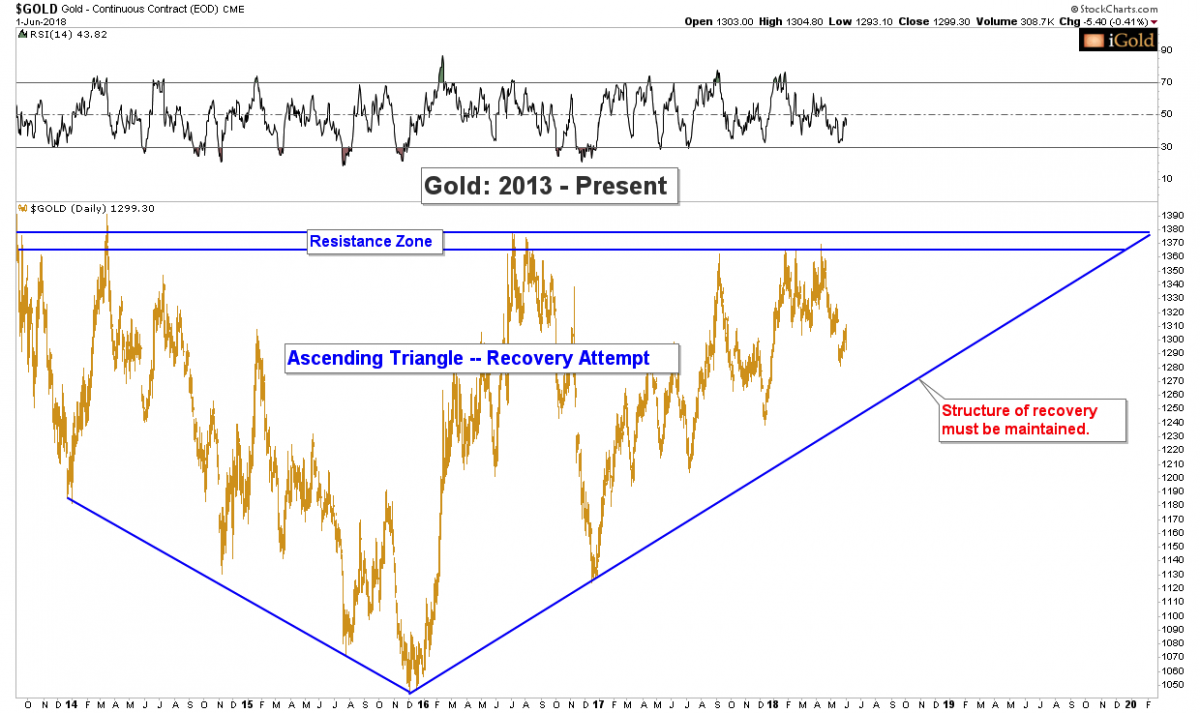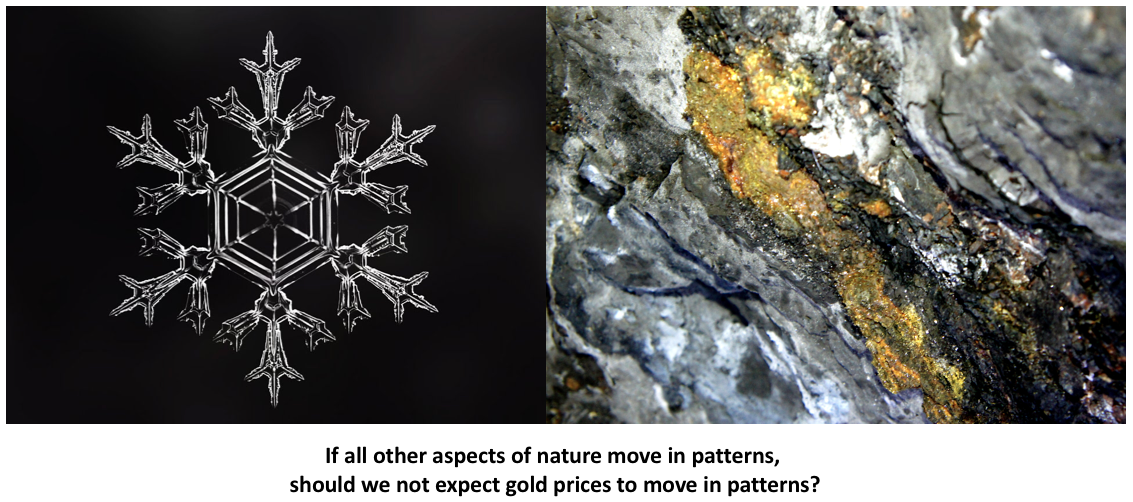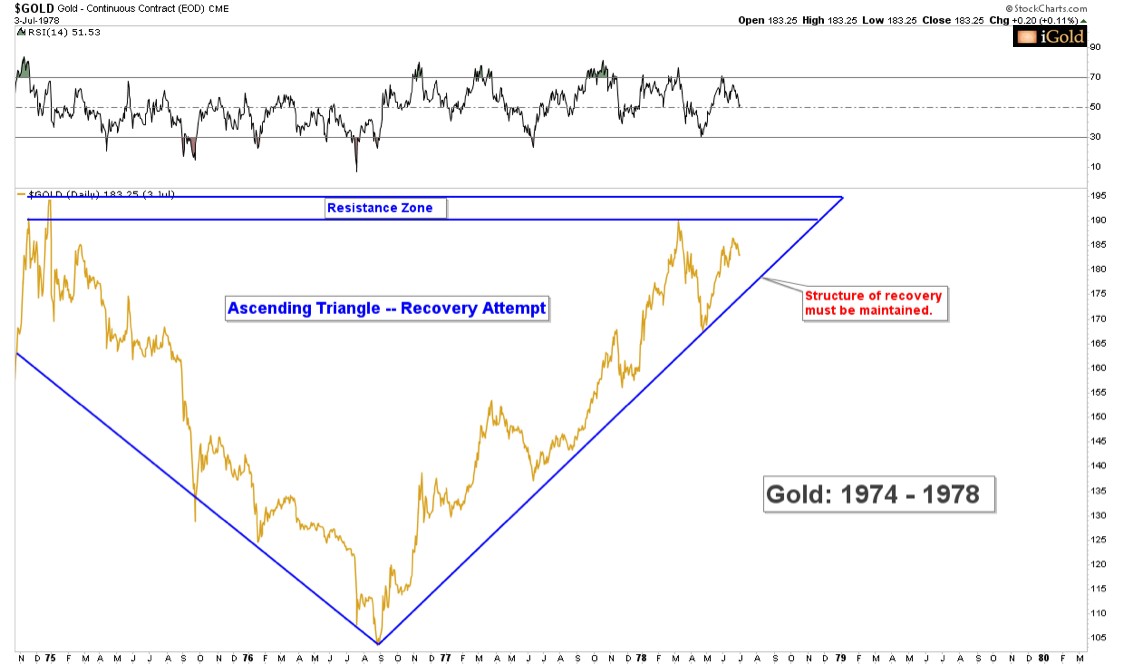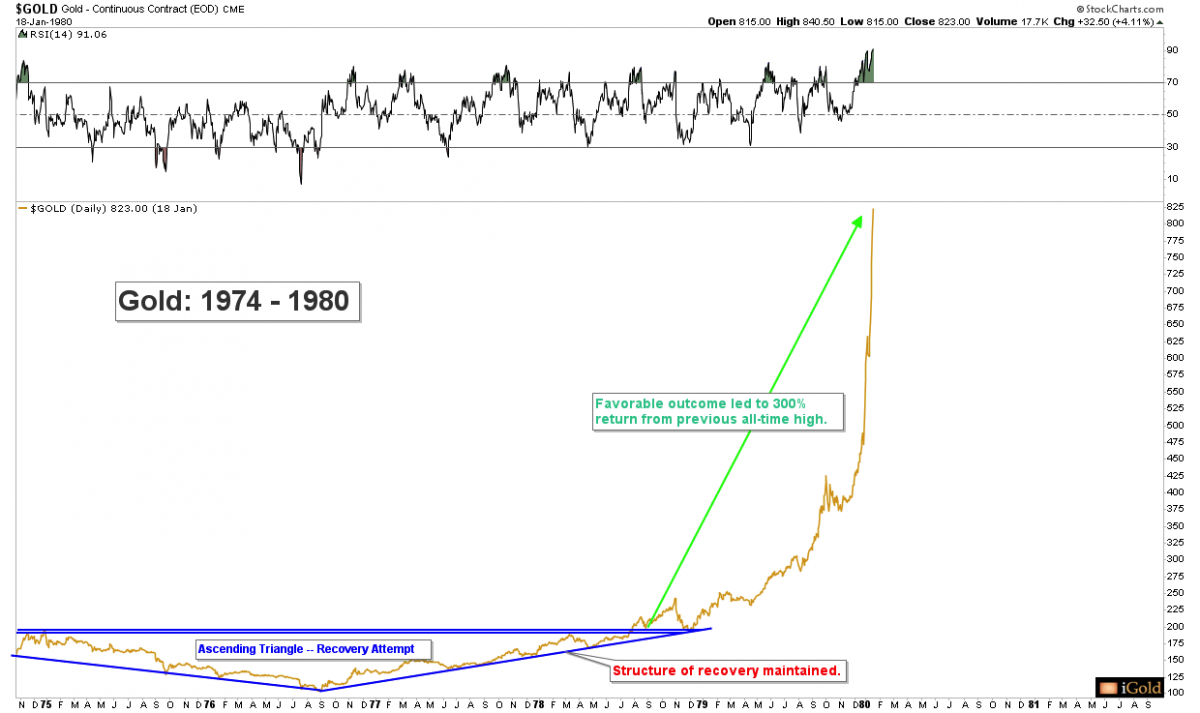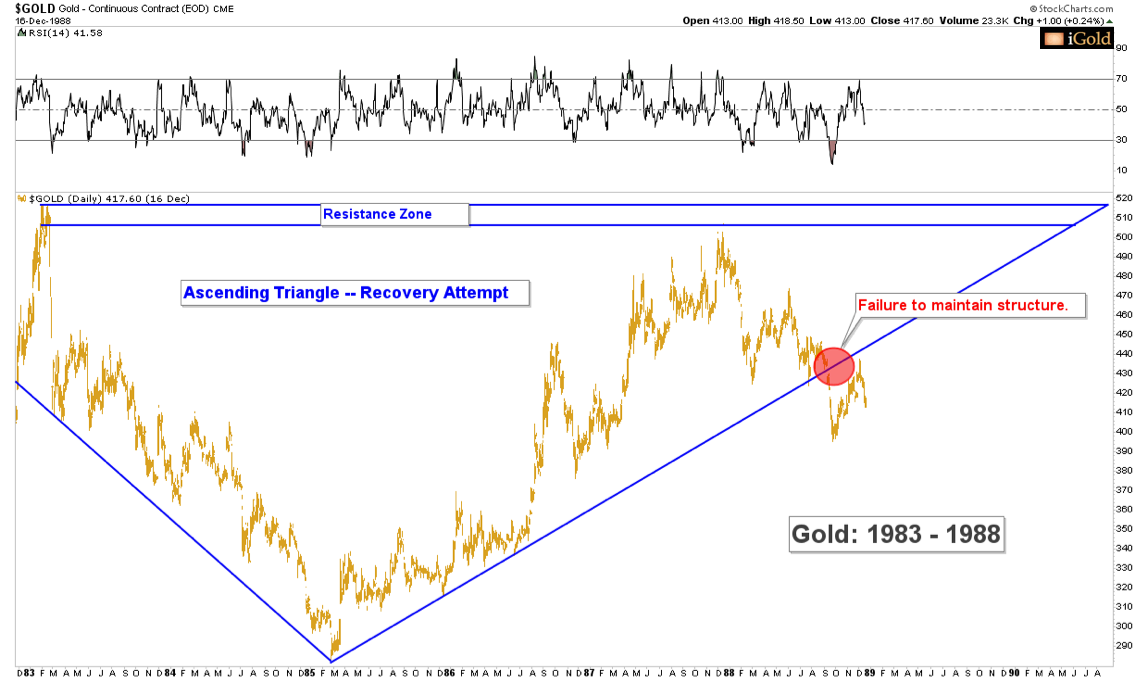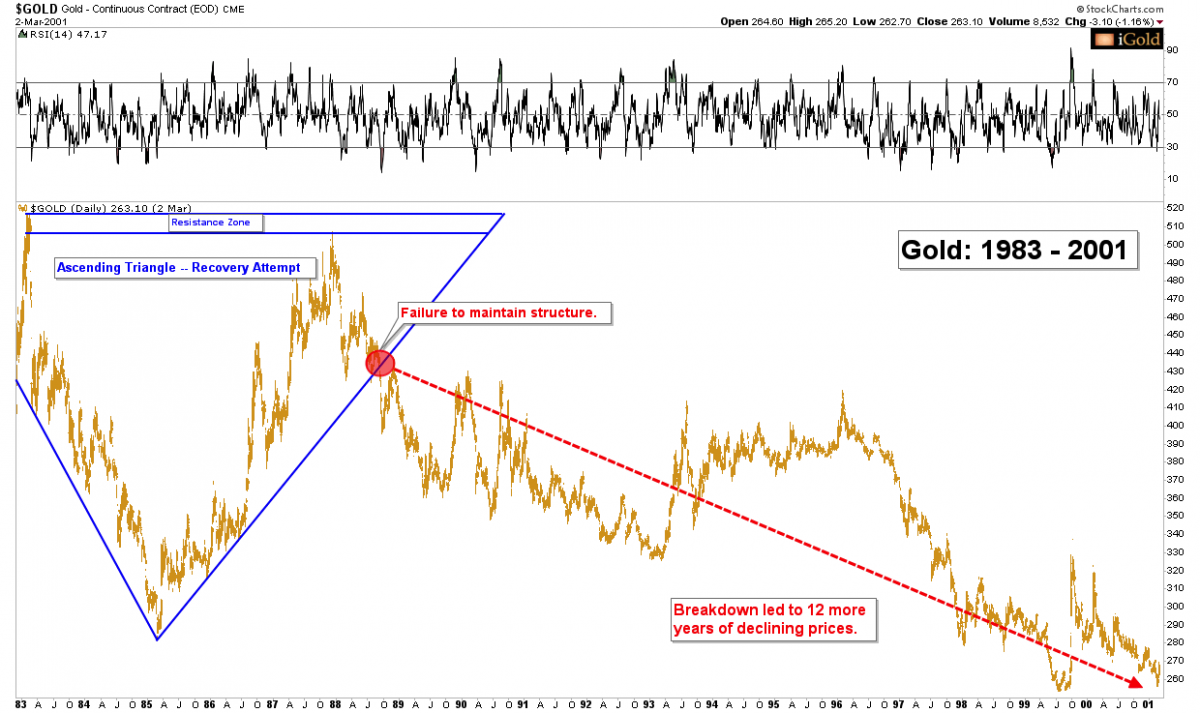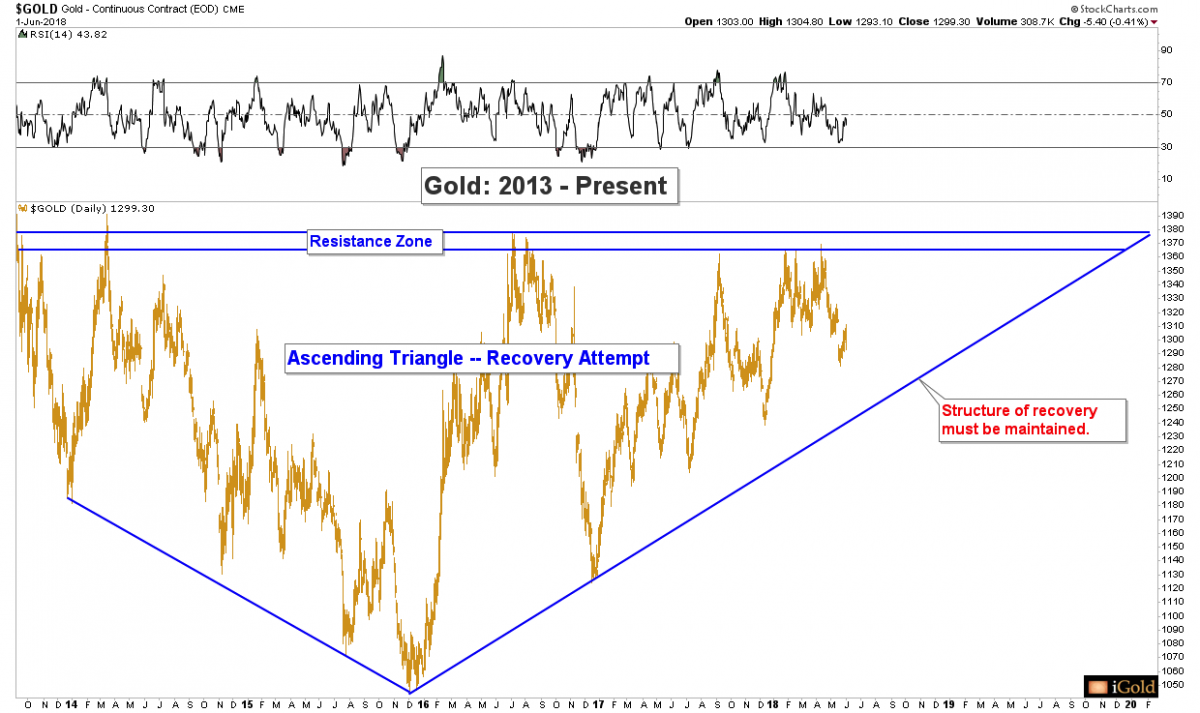Gold Price Forecast: Recovery Pattern Must Be Maintained

Gold is in a primary recovery pattern as it attempts to break above its 2016 peak of $1,378 per ounce. This recovery pattern appears over and over again throughout history – the success or failure of gold to maintain the structure of this pattern will pave the way for either a massive multi-year advance higher in the sector, or a grinding decline to last for the majority of the next decade.
We will have the answer to the question of which outcome to expect within the next 12-18 months.
It will behoove precious metals investors to pay close attention to the technical action and to tune out misleading rhetoric coming from both perma-bulls and perma-bears of gold and the precious metals sector.
Gold’s Recovery Pattern
The primary pattern that gold now finds itself in is a recovery formation. Gold is attempting to recover from the losses sustained after its 2011 peak at $1,923 per ounce. In order to do this, buyers must come in at increasingly higher levels and scoop up gold for sale. The shape of the pattern thus takes on the form of an ascending triangle, as buyers emerge at higher and higher price intervals, shown below in blue:
The pattern is clear to see for those looking with the proper technical lens. We are referring here to a flat horizontal resistance band of sellers which exists below $1,400 per ounce since 2013, and a rising pattern of new buyers entering the market.
This is shown in blue, and forms an ascending triangle.
Within the next 12 - 18 months, one of these groups will be overcome, either the sellers or the buyers. The pattern will be resolved. The outcome of this resolution will have tremendous significance for precious metals investors for many years to come.
The Recovery Pattern Throughout History
Markets are a function of human nature. Human nature is in turn a function of the larger natural world around us. Both human nature and the world around us move in patterns.
While no two examples from history will ever prove exactly the same – just as no two snowflakes that fall from the sky are ever exactly the same – sufficient commonalities exist for us to draw solid conclusions based on history: for example, all snowflakes are white, cold, and crystalline in structure.
Let us consider gold, the 5,000 year old store of wealth. Individuals have been buying and selling gold for millennia and for a multitude of reasons. Some have sought to preserve wealth. Some have sought to make a short-term profit. Others have desired gold for its innate beauty.
These traits for the metal last throughout time.
If gold’s properties last throughout time, should we not expect that human interaction with gold will also repeat throughout time?
Of course we should. Civilization and gold have existed alongside one another since the dawn of record keeping. Humans move in patterns in all walks of life – and they also move in patterns when it comes to buying and selling gold.
A Successful Recovery
Let us consider the same triangular pattern in a successful recovery attempt for gold. Below we show the price action in gold from 1974 – 1978, as the metal declined from just under $200 down to nearly $100 within the course of two years, only to recover fully back to $200 by mid-1978. Note the clear ascending triangle pattern, shown in blue. This is quite similar to the pattern presented today (see chart above):
The key takeaway at this juncture is to note how the structure of the recovery pattern was maintained (red callout). At no point from 1976 through 1978 did the gold price decline below the rising trend which formed the advance side of the triangle. Buyers emerged at higher and higher intervals for nearly two years straight.
What was the result of a successful recovery attempt? To demonstrate, we advance the above chart by 18-months further:
Note how the maintenance of the rising structure in the recovery pattern then led to a major advance featuring over a 300% gain from the previous all-time high, as gold moved from $200 per ounce to over $800 by 1980.
Fortunes were made when gold recovered and then exceeded its resistance zone of sellers, the blue horizontal lines which formerly acted as a top before 1978.
Gold In A Failed Recovery
For proper balance, let us consider a recovery attempt by gold which did not resolve positively. The following example shows gold from 1983 – 1988, in which the metal fell from above $500 in 1983 down to below $290 by 1985, only to make a recovery to $500 again by 1987:
Yet note how instead of maintaining the structure of the recovery, in 1988 gold softened and broke the advancing trend of the triangle by breaking below $430 in September (red callout). Surely, those who were not following the pattern must have hoped that gold was still in recovery mode, set to eclipse $500 at any moment and then to advance again beyond the 1980 peak at $850.
Did a successful recovery occur? How important was the breaking of the recovery triangle in 1988?
Let us advance the above chart by another 12 years:
The proof is plain to see.
The breaking of a primary trendline of an ascending triangle recovery pattern led to a further 12 years of declining gold prices.
Further, gold did not recover the $500 level until 2005, 18 full years after the attempt in 1987. Can we imagine buying gold in 1987 and not recovering that purchase for nearly two decades?
This may seem unfathomable to some, but it is the actual history of gold prices following the failed recovery attempt of the early 1980’s.
Key Takeaway On Gold Recovery
The key takeaway is that it is critical for a gold recovery attempt to maintain structural integrity. We can observe this through a valid trend or series of trends which emerge from the low, and which must show gold making steady progress to overcome a horizontal zone of sellers.
Anything else during a recovery attempt can lead to decades of losses.
Back To The Present
We now present again the chart of gold from 2013 – present. It should be abundantly clear how important it is that we continue to see buyers emerge for gold at increasingly higher levels, as the precious metal attempts to recover from the losses of the previous five years:
Thus far, gold has seen horizontal resistance below $1,400.
Buyers have been showing up at increasingly higher levels, first at $1,045 in December 2015, then at $1,122 in December 2016, then at $1,236 in December 2017. Thus far, the structure of the advancing trend is sound.
Yet gold must do more now than simply move sideways. In order for the present consolidation to resolve favorably, gold must, within the next 12 – 18 months, exceed its 2016 peak at $1,378 and advance strongly into the $1,400’s.
Anything less will result in a breaking of the rising triangle, similar to what occurred in 1988, which then saw investors fail to recover losses for 18 years.
The support zone for gold is now $1,240 and rising each week. Gold buyers must show up above this figure in order for the integrity of the recovery attempt to remain valid.
Anything less will result in a violation of a repeating gold recovery pattern which has been seen time and time again throughout history. A major bull market requires a defined recovery in prices; meanwhile, a languishing market for decades can result from the failure of such.
Investors in gold, silver and the mining shares should pay close attention to the integrity of this pattern over the next 12 – 18 months.
*********

